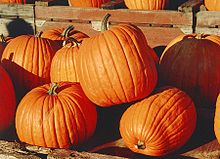| Revision as of 22:15, 29 October 2004 view source65.113.42.250 (talk) corrected spelling error← Previous edit | Revision as of 04:05, 1 November 2004 view source 69.14.16.77 (talk) species -> lcNext edit → | ||
| Line 3: | Line 3: | ||
| A '''pumpkin''' is an orange gourd (]) growing from a trailing vine, commonly used in pies or in carving ]s for use as part of ] celebrations. | A '''pumpkin''' is an orange gourd (]) growing from a trailing vine, commonly used in pies or in carving ]s for use as part of ] celebrations. | ||
| A pumpkin is the fruit of the gourd ''Cucurbita |
A pumpkin is the fruit of the gourd ''Cucurbita pepo'', a native plant of the Western hemisphere. Today, it is well-known in English ] ]s, and largely cultivated in continental ] and ]. | ||
| The pumpkin varies much in form, being sometimes nearly globular, but more generally ] or ] in shape; the rind is smooth and very variable in colour. | The pumpkin varies much in form, being sometimes nearly globular, but more generally ] or ] in shape; the rind is smooth and very variable in colour. | ||
Revision as of 04:05, 1 November 2004

A pumpkin is an orange gourd (Cucurbitaceae) growing from a trailing vine, commonly used in pies or in carving Jack o'lanterns for use as part of Halloween celebrations.
A pumpkin is the fruit of the gourd Cucurbita pepo, a native plant of the Western hemisphere. Today, it is well-known in English cottage gardens, and largely cultivated in continental Europe and North America.
The pumpkin varies much in form, being sometimes nearly globular, but more generally oblong or ovoid in shape; the rind is smooth and very variable in colour.
It is a useful plant to the American backwoods farmer, yielding, both in the ripe and unripe condition, a valuable fodder for his cattle and pigs, being frequently planted at intervals among the maize that constitutes his chief crop. The larger kinds acquire a weight of 40 to 80 lb (18 to 36 kg) but smaller varieties are in more esteem for garden culture. When ripe, the pumpkin is boiled or baked, or made into various kinds of pie, alone or mixed with other fruit; while small and green it may be eaten like the vegetable marrow. The name squash is applied in America to this and other species of the genus Cucurbita. The name is adapted from an American Indian word (see L. H. Bailey, Cyclopaedia of American Horticulture, where is a fuller account of the squashes).

Summer squashes are mostly varieties of Cucurbita pepo; winter squashes are either C. maxima or C. moschata. The varieties of pumpkins and squashes are numerous and great variety in size and shape; it is difficult to keep them pure if various kinds are grown together, but the true squash (C. maxima) do not hybridize with the true pumpkin species. If carefully handled to avoid cracking of the skin, and kept dry and fairly warm, winter squashes may be kept for months.
Studies by the Royal Military College of Canada show promise for pumpkins and other members of the Cucurbita Pepo family to be viable candidates for DDT phytoremediation. (see Sientific American, October 25, 2004)
Pumpkins have historically been pollinated by the native squash bee Peponapis pruinosa, but this bee has declined, probably due to pesticide sensitivity, and most commercial plantings are pollinated by honeybees today. One hive per acre (4,000 m² per hive) is recommended by the US Department of Agriculture. Gardeners with a shortage of bees often have to hand pollinate. Inadequately pollinated pumpkins usually start growing but abort before full development. Often there is an opportunistic fungus that the gardener blames for the abortion, but the fix proves to be better pollination not fungicide.

Pumpkins are grown today in the US more for decoration than for food, and popular contests lead growers to vie for a new world record for the largest pumpkin grown. Growers have many techniques, some kept secret, but often include picking off all but one pumpkin, hand pollination, and injection of fertilizer or even milk directly into the vines with a hypodermic needle.
Illinois produces the most pumpkins in the United States.
The largest pumpkin ever grown was of the variety "Dill's Atlantic Giant." The giant pumpkin was developed by Canadian breeder Howard Dill. It was 1,458 lbs and grown by Bruce Whittier from Henniker, New Hampshire. Another notable record relating to pumpkins in New Hampshire is from the town of Keene, New Hampshire which currently holds a world record for the most lit pumpkins in one location.
Pumpkin chunking is a competitive activity, involving teams building various mechanical devices to throw a pumpkin for the furthest distance. Catapults, trebuchets, ballistas, and air cannons are the most common designs. Some pumpkin chunkers grow special varities of pumpkin, bred and grown under conditions to improve the pumpkin's chances of surviving being thrown.